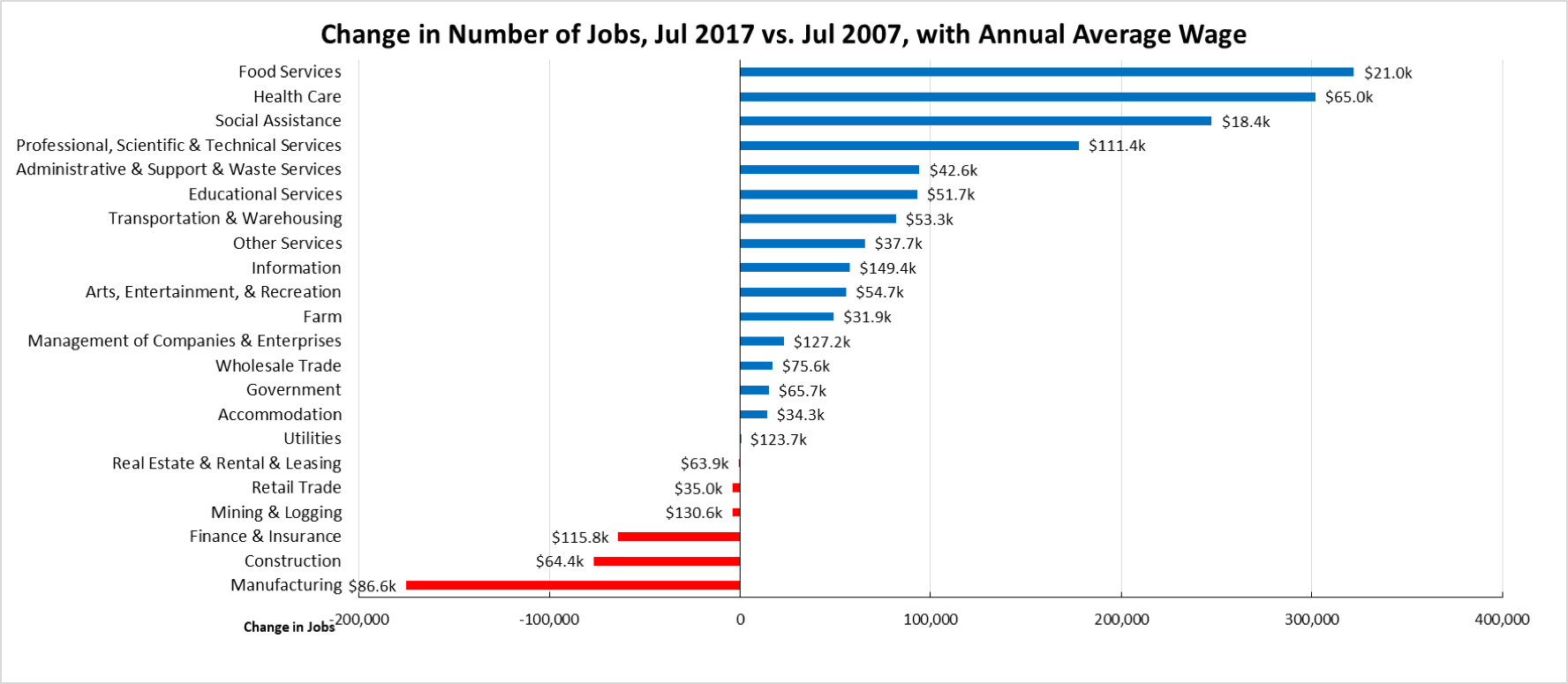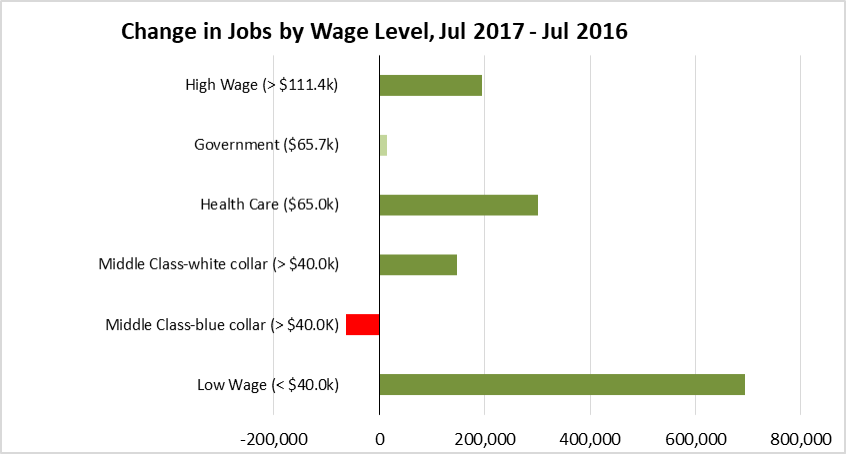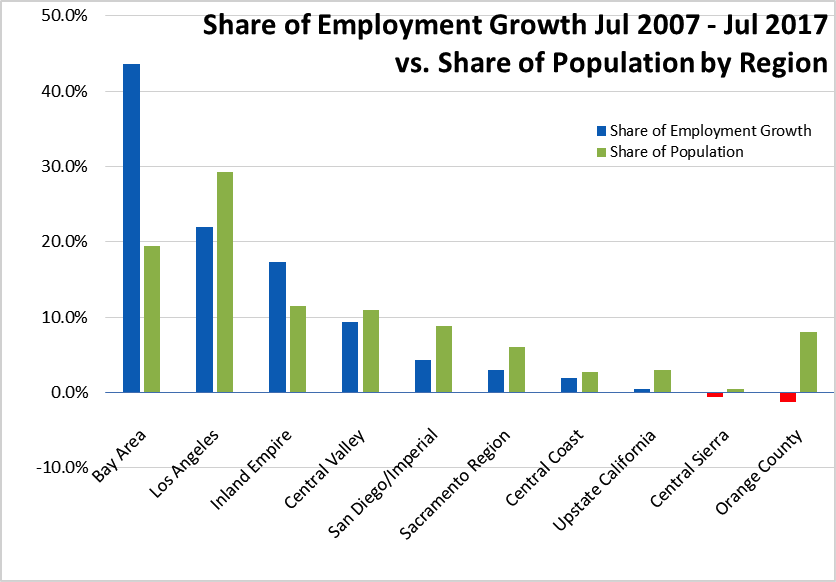Highlights for policy makers:
- Unemployment Rate Rises to 4.8%; Total Employment Drops 24,900
- Labor Force Participation Rate Remains at Lowest Level Since 1976
- State Employment Growth Rankings—California Drops to 5th Place
- Nonfarm Jobs Up 82,600
- 6 Industries below 2007 Pre-Recession Job Levels
- Job Gains by Wage Level
- Two-Tier Economy Persists—Central Valley Unemployment More than Twice as High as Bay Area
- Bay Area Provided 44% of Net Employment Growth Since Recession
- 8 California MSAs in the 10 Worst Unemployment Rates Nationally
Unemployment Rate Rises to 4.8%; Total Employment Drops 24,900
The Labor Force data for July 2017 (seasonally adjusted; California preliminary) is shown below, along with the change from the prior month:
| Seasonally Adjusted | California | US | ||
|---|---|---|---|---|
| Jul 2017 | Change from Jun 2017 | Jul 2017 | Change from Jun 2017 | |
| Unemployment Rate | 4.8% | 0.1 | 4.3% | -0.1 |
| Labor Force | 19,136,400 | 0.0% | 160,494,000 | 0.2% |
| Participation Rate | 61.9% | 0.0 | 62.9% | 0.1 |
| Employment | 18,211,700 | -0.1% | 153,513,000 | 0.2% |
| Unemployment | 924,700 | 2.6% | 6,981,000 | 0.1% |
The related not seasonally adjusted numbers (California preliminary), with the change from July 2016:
| Not Seasonally Adjusted | California | US | ||
|---|---|---|---|---|
| Jul 2017 | Change from Jul 2016 | Jul 2017 | Change from Jul 2016 | |
| Unemployment Rate | 5.4% | -0.4 | 4.6% | -0.5 |
| Labor Force | 19,285,000 | 0.4% | 161,911,000 | 0.8% |
| Participation Rate | 62.3% | -0.3 | 63.5% | 0.1 |
| Employment | 18,251,500 | 0.9% | 154,470,000 | 1.3% |
| Unemployment | 1,033,500 | -7.3% | 7,441,000 | -10.0% |
California Employment Development Department’s (EDD) latest release shows on a seasonally adjusted basis, total employment dropped 24,900 from June, while the number of unemployed rose by 23,500. The labor force remained essentially unchanged with a decline of only 1,400.
California’s seasonally adjusted unemployment rate rose a tenth of a point to 4.8%. California tied with Delaware and Nevada for the 11th highest unemployment rate among the states. The unadjusted rate dropped from 5.8% in July 2016 to 5.4%.
Total US employment saw a seasonally adjusted increase of 345,000 from June, while the number of unemployed was largely unchanged with an increase of only 4,000. The national unemployment rate was down 0.1 point to 4.3%. The national labor force numbers expanded by 349,000.
Labor Force Participation Rate at Lowest Level Since 1976
California’s participation rate (seasonally adjusted) in July was unchanged at 61.9%, while the US rate rose to 62.9%.
The seasonally adjusted California participation rate in July remained at its lowest level since 1976.
State Employment Growth Rankings—California Drops to 5th Place
| Rank | Number of Employed | Percentage Change | Population Adjusted (employment growth per 1,000 civilian noninstitutional population) |
|---|---|---|---|
| 1 | FL 364,100 | OR 4.5% | CO 27.0 |
| 2 | TX 182,600 | CO 4.2% | OR 26.8 |
| 3 | NY162,800 | UT 4.0% | UT 26.2 |
| 4 | GA 143,400 | FL 3.9% | FL 21.9 |
| 5 | CA 140,100 | KY 3.1% | GA 18.2 |
| 6 | CO 116,900 | GA 3.1% | KY 17.1 |
| 7 | VA 96,600 | AR 3.0% | AR 17.0 |
| 8 | WA 92,500 | WA 2.7% | DC 16.6 |
| 9 | OR 88,100 | DC 2.5% | WA 16.1 |
| 10 | MA 77,700 | MD 2.5% | MD 15.8 |
| 11 | NC 76,500 | WI 2.4% | WI 15.6 |
| 12 | MD 74,700 | VA 2.4% | VA 14.8 |
| 13 | MI 71,500 | AZ 2.3% | CT 14.3 |
| 14 | AZ 71,100 | CT 2.3% | MA 14.1 |
| 15 | WI 71,100 | MA 2.2% | AZ 13.2 |
| 16 | KY 59,000 | ME 2.0% | MN 12.6 |
| 17 | UT 57,800 | NV 2.0% | ME 12.1 |
| 18 | MN 54,300 | RI 1.9% | RI 11.7 |
| 19 | OH 47,900 | MN 1.9% | NV 11.5 |
| 20 | IN 47,700 | SC 1.9% | SC 10.5 |
| 21 | TN 43,900 | NY 1.8% | NY 10.3 |
| 22 | PA 43,600 | NC 1.7% | ND 10.1 |
| 23 | SC 41,000 | MI 1.6% | NC 9.7 |
| 24 | CT 40,900 | IN 1.5% | IN 9.3 |
| 25 | NJ 39,500 | HI 1.5% | MI 9.1 |
| 26 | AR 39,200 | TN 1.5% | HI 9.0 |
| 27 | NV 26,400 | ND 1.5% | TX 8.7 |
| 28 | AL 21,500 | TX 1.4% | TN 8.4 |
| 29 | MS 17,000 | MS 1.4% | AK 8.1 |
| 30 | ME 13,300 | AK 1.3% | ID 7.6 |
| 31 | RI 10,000 | ID 1.2% | MS 7.4 |
| 32 | HI 9,800 | AL 1.1% | AL 5.6 |
| 33 | ID 9,700 | NM 1.0% | NJ 5.6 |
| 34 | DC 9,300 | NJ 0.9% | NM 5.3 |
| 35 | KS 9,200 | OH 0.9% | OH 5.2 |
| 36 | NM 8,500 | WV 0.8% | CA 4.6 |
| 37 | OK 6,600 | CA 0.8% | PA 4.3 |
| 38 | WV 6,000 | PA 0.7% | SD 4.3 |
| 39 | ND 5,900 | KS 0.6% | KS 4.2 |
| 40 | AK 4,400 | SD 0.6% | WV 4.1 |
| US 1,967,000 | US 1.3% | US 7.8 |
Between July 2016 and July 2017, Bureau of Labor Statistics (BLS) data shows the total number of employed in California increased by 140,100 (seasonally adjusted), or 7.1% of the total net employment gains in this period for the US. California dropped to 5th place behind Florida (which has a civilian working age population only 55% as large as California’s) at 400,700, Texas (68% as large) at 220,800, New York at 162,800, and Georgia at 143,400. Measured by percentage change in employment over the year, California remained at 37th highest. Adjusted for working age population, California remained at 36th.
Nonfarm Jobs Up 82,600
EDD reported that between June and July 2017, seasonally adjusted nonfarm wage and salary jobs grew by 82,600. June’s losses were revised to 3,200 from the previously reported loss of 1,400.
Looking at the not seasonally adjusted nonfarm numbers, hiring saw increases in all but three industries over the year. The change in total payroll jobs from July 2016 saw the largest increases in Construction (48,900), Government (44,900), and Food Services (42,600). Declines continued in Manufacturing (-13,700), Mining & Logging (-1,300), and Utilities (-700).
| Not Seasonally Adjusted Payroll Jobs | Jul 2017 | Jun 2017 | Change Jul 2017 – Jun 2017 | Change Jul 2017 – Jul 2016 |
|---|---|---|---|---|
| Total Farm | 485,100 | 486,100 | -1,000 | 4,200 |
| Mining and Logging | 23,800 | 23,700 | 100 | -1,300 |
| Construction | 841,900 | 827,700 | 14,200 | 48,900 |
| Manufacturing | 1,308,100 | 1,299,900 | 8,200 | -13,700 |
| Wholesale Trade | 737,900 | 737,400 | 500 | 13,600 |
| Retail Trade | 1,671,500 | 1,666,300 | 5,200 | 1,800 |
| Utilities | 58,300 | 58,300 | 0 | -700 |
| Transportation & Warehousing | 534,500 | 536,300 | -1,800 | 6,100 |
| Information | 529,500 | 525,300 | 4,200 | 7,300 |
| Finance & Insurance | 549,300 | 548,000 | 1,300 | 1,900 |
| Real Estate & Rental & Leasing | 285,200 | 282,300 | 2,900 | 3,400 |
| Professional, Scientific & Technical Services | 1,232,200 | 1,229,300 | 2,900 | 1,100 |
| Management of Companies & Enterprises | 231,400 | 229,500 | 1,900 | 4,600 |
| Administrative & Support & Waste Services | 1,098,400 | 1,103,600 | -5,200 | 15,400 |
| Educational Services | 341,500 | 357,700 | -16,200 | 21,900 |
| Health Care | 1,486,000 | 1,482,400 | 3,600 | 22,900 |
| Social Assistance | 752,500 | 752,600 | -100 | 36,400 |
| Arts, Entertainment & Recreation | 323,700 | 316,200 | 7,500 | 9,000 |
| Accommodation | 230,400 | 231,300 | -900 | 2,100 |
| Food Services | 1,431,100 | 1,422,300 | 8,800 | 42,600 |
| Other Services | 580,000 | 579,800 | 200 | 19,100 |
| Government | 2,422,500 | 2,593,600 | -171,100 | 44,900 |
| Total Nonfarm | 16,669,700 | 16,803,500 | -133,800 | 287,300 |
| Total Wage and Salary | 17,154,800 | 17,289,600 | -134,800 | 291,500 |
By total number of new jobs, California continued to show the second highest increase in seasonally adjusted nonfarm jobs among the states from July 2016 to July 2017, at 276,400 or 12.8% of the US net increase. Texas led jobs growth with 293,400 jobs and Florida was third with 226,200. By percentage growth in jobs, California rose to 16th highest at 1.9%, above the US average of 1.5%. By population adjusted jobs growth, California rose to 20th highest, slightly above the US average.
| Rank | Number of Jobs | Employment Growth (%) | Population Adjusted (jobs growth per 1,000 civilian noninstitutional population) |
|---|---|---|---|
| 1 | TX 293,400 | OR 2.9% | DC 33.4 |
| 2 | CA 276,400 | NV 2.7% | UT 16.5 |
| 3 | FL 226,200 | FL 2.7% | OR 16.2 |
| 4 | NY 138,100 | AR 2.7% | NV 15.5 |
| 5 | GA 96,200 | UT 2.5% | AR 14.2 |
| 6 | WA 71,300 | TX 2.4% | TX 14.1 |
| 7 | NC 64,400 | DC 2.4% | MN 14.0 |
| 8 | MI 62,400 | ID 2.3% | FL 13.6 |
| 9 | PA 61,600 | WA 2.2% | WA 12.4 |
| 10 | MN 60,400 | GA 2.2% | ID 12.3 |
| 11 | VA 60,300 | MN 2.1% | MO 12.2 |
| 12 | MO 58,200 | MO 2.0% | GA 12.2 |
| 13 | OR 53,400 | MD 1.9% | ND 11.3 |
| 14 | MD 51,000 | NH 1.8% | NH 10.9 |
| 15 | TN 49,100 | RI 1.7% | MD 10.8 |
| 16 | OH 47,500 | CA 1.7% | CO 10.0 |
| 17 | NJ 47,300 | CO 1.7% | RI 9.9 |
| 18 | MA 45,200 | TN 1.7% | TN 9.4 |
| 19 | CO 43,400 | AL 1.6% | VA 9.2 |
| 20 | UT 36,300 | VA 1.5% | CA 9.0 |
| 21 | NV 35,700 | ND 1.5% | NY 8.7 |
| 22 | AZ 33,300 | NC 1.5% | NE 8.7 |
| 23 | IL 33,200 | NY 1.5% | AL 8.2 |
| 24 | AR 32,700 | SC 1.4% | MA 8.2 |
| 25 | AL 31,400 | MI 1.4% | NC 8.2 |
| 26 | SC 29,800 | MA 1.3% | MI 7.9 |
| 27 | IN 27,300 | HI 1.2% | SC 7.7 |
| 28 | WI 26,500 | NE 1.2% | HI 7.4 |
| 29 | KY 23,300 | AZ 1.2% | KY 6.7 |
| 30 | DC 18,700 | KY 1.2% | NJ 6.7 |
| 31 | OK 18,200 | NJ 1.2% | IA 6.5 |
| 32 | IA 15,900 | MT 1.1% | MT 6.3 |
| 33 | ID 15,700 | OK 1.1% | AZ 6.2 |
| US 2,158,000 | US 1.5% | US 8.5 |
Six Industries Below 2007 Pre-Recession Job Levels

Comparing the number of jobs by industry in July 2017 (not seasonally adjusted), 6 industries had employment below the 2007 pre-recession levels. The highest gain industries were led by lower wage Food Services, Health Care (with relatively higher mix of lower and higher wage occupations), lower wage Social Assistance, and higher wage Professional, Scientific & Technical Services. Of the lagging industries, three—Manufacturing, Mining & Logging, and Construction—are blue collar middle class wage industries, while the higher wage Finance & Insurance also continued to lose ground.
Job Gains by Wage Level
In the recent May Budget Revision, the Governor again pointed to the increasing share of lower wage jobs as one of the prime causes of slowing state revenues growth: The level of wages has been revised downward, and cash receipts have been significantly below forecast. The following chart illustrates this trend for total wage and salary jobs, according to the industry wage classification used previously in other Center analyses of this issue. As indicated, over half of jobs growth over the past 12 months has been in the low wage industries. Middle Class-blue collar jobs show a decline.

Two-Tier Economy Persists
Unemployment rates (all data is not seasonally adjusted) continue to vary widely across the state, ranging from 3.9% in the Bay Area to more than twice as large at 8.9% in the Central Valley.
| Not Seasonally Adjusted | Unemployment Rate (%) MAY 2017 |
|---|---|
| California | 5.4 |
| Bay Area | 3.9 |
| Orange County | 4.2 |
| Sacramento Region | 5.1 |
| Los Angeles | 5.2 |
| Central Coast | 5.3 |
| Central Sierra | 5.4 |
| San Diego/Imperial | 5.6 |
| Inland Empire | 6.1 |
| Upstate California | 6.5 |
| Central Valley | 8.9 |
By Legislative District:
| Lowest 10 Unemployment Rates | |||||
|---|---|---|---|---|---|
| CD18 (Eshoo-D) | 3.0 | SD13 (Hill-D) | 3.0 | AD16 (Baker-R) | 2.8 |
| CD12 (Pelosi-D) | 3.2 | SD11 (Wiener-D) | 3.5 | AD22 (Mullin-D) | 2.9 |
| CD52 (Peters-D) | 3.4 | SD39 (Atkins-D) | 3.7 | AD24 (Berman-D) | 3.1 |
| CD45 (Walters-R) | 3.5 | SD37 (Moorlach-R) | 3.7 | AD28 (Low-D) | 3.2 |
| CD14 (Speier-D) | 3.5 | SD36 (Bates-R) | 3.8 | AD77 (Maienschein-R) | 3.4 |
| CD17 (Khanna-D) | 3.5 | SD26 (Allen-D) | 3.9 | AD17 (Chiu-D) | 3.4 |
| CD33 (Lieu-D) | 3.8 | SD07 (Glazer-D) | 4.0 | AD19 (Ting-D) | 3.5 |
| CD15 (Swalwell-D) | 3.8 | SD15 (Beall-D) | 4.0 | AD78 (Gloria-D) | 3.5 |
| CD49 (Issa-R) | 3.8 | SD10 (Wieckowski-D) | 4.0 | AD73 (Brough-R) | 3.6 |
| CD27 (Chu-D) | 4.0 | SD02 (McGuire-D) | 4.2 | AD25 (Chu-D) | 3.6 |
| Highest 10 Unemployment Rates | |||||
|---|---|---|---|---|---|
| CD36 (Ruiz-D) | 6.8 | SD31 (Roth-D) | 6.1 | AD03 (Gallagher-R) | 7.3 |
| CD41 (Takano-D) | 6.8 | SD04 (Nielsen-R) | 6.2 | AD64 (Gipson-D) | 7.5 |
| CD09 (McNerney-D) | 7.2 | SD21 (Wilk-R) | 6.3 | AD23 (Patterson-R) | 7.6 |
| CD44 (Barragán-D) | 7.3 | SD35 (Bradford-D) | 6.4 | AD34 (Fong-R) | 7.7 |
| CD10 (Denham-R) | 7.5 | SD08 (Berryhill-R) | 7.3 | AD13 (Eggman-D) | 8.2 |
| CD23 (McCarthy-R) | 8.4 | SD05 (Galgiani-D) | 7.5 | AD21 (Gray-D) | 9.8 |
| CD22 (Nunes-R) | 8.5 | SD12 (Cannella-R) | 8.1 | AD31 (Arambula-D) | 10.0 |
| CD16 (Costa-D) | 9.9 | SD16 (Fuller-R) | 8.2 | AD26 (Mathis-R) | 10.5 |
| CD21 (Valadao-R) | 10.9 | SD40 (Hueso-D) | 9.7 | AD32 (Salas-D) | 11.5 |
| CD51 (Vargas-D) | 11.5 | SD14 (Vidak-R) | 11.9 | AD56 (Garcia-D) | 13.3 |
Bay Area Provided 44% of Net Employment Growth Since Recession
Containing just under 20% of the state’s population, the Bay Area was responsible for 43.6% of the net growth in employment since the pre-recession peaks in 2007. Los Angeles Region provided the next largest share at 22.0%, but spread over 29.2% of the population. Inland Empire is the only other region continuing to show employment gains above their population share.

Eight California MSAs in the 10 Worst Unemployment Rates Nationally
According to BLS data, of the 10 Metropolitan Statistical Areas (MSAs) with the worst unemployment rates nationally, 8 are in California. Of the 20 worst, 10 are in California.
| US Rank | MSA | June 2017 Rate |
|---|---|---|
| 378 | Yuba City, CA Metropolitan Statistical Area | 8.0 |
| 380 | Madera, CA Metropolitan Statistical Area | 8.1 |
| 381 | McAllen-Edinburg-Mission, TX Metropolitan Statistical Area | 8.3 |
| 382 | Fresno, CA Metropolitan Statistical Area | 8.4 |
| 383 | Hanford-Corcoran, CA Metropolitan Statistical Area | 9.2 |
| 384 | Merced, CA Metropolitan Statistical Area | 9.4 |
| 385 | Bakersfield, CA Metropolitan Statistical Area | 9.5 |
| 386 | Visalia-Porterville, CA Metropolitan Statistical Area | 9.9 |
| 387 | Yuma, AZ Metropolitan Statistical Area | 20.5 |
| 388 | El Centro, CA Metropolitan Statistical Area | 20.8 |
Note: All data sources, methodologies, and historical data series available at CenterforJobs.org.
